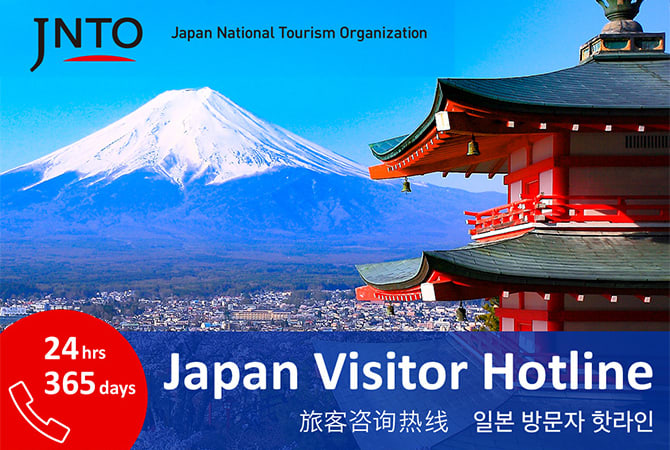

FAQ
Visiting Japan
Q : Do I need any vaccinations before coming to Japan?
No vaccinations are required for foreign travelers coming to Japan.
Q : Do I need a visa?
Currently, Japan has agreements with 67 countries allowing these citizens to enter Japan without the need for a visa. Nationals of all other countries will require a visa.
Q : What can I bring through Customs?
Baggage or accompanying items which are deemed as being for personal use only, and are within the restricted quantity of duty-free as specified by the customs regulations. Find out more about Customs rules and regulations from the JNTO: Customs
Q : Are credit cards widely accepted? Would you recommend bringing Travelers Checks, cash or credit cards?
Although most stores and restaurants will accept Visa, MasterCard and American Express cards, travelers should keep in mind that Japan is still very much a cash culture. You may find smaller shops or remote ryokan hotels that only accept yen in cash. More than 26,000 Post Office ATMs exist at various locations throughout Japan, and stickers indicate whether a Post Office has an ATM machine. Cirrus, Plus, Maestro and Visa Electron networks are accepted, as are Visa, MasterCard, American Express and Diners Club credit cards.
Japan has one of the lowest crime rates in the world, so carrying cash is not a real problem. Travelers Checks are also an option, although it is wise to have these available in either Japanese yen, or US dollars. Travelers Checks may not be accepted outside of major hotels and banks.
Q : Can I use my cell phone in Japan?
This can vary depending on your network provider. Before arriving in Japan, make sure to confirm the compatibility of your mobile phone with your phone line service provider. It is worth noting that rental phones, sim cards and Wi-Fi are available in Japan on varying plans and costs. Most major airports have kiosks offering these services. Do your research to find out what makes the most sense for you.
Q : Is Japan expensive?
Japan is an affordable place to travel, even for those on a tight budget. There is a wide variety of budget accommodation, transport passes, and sightseeing discounts to help support the JNTO: Budget Travel Hints
In reality, Tokyo and other large Japanese cities are not any more expensive than other big cities worldwide. If you make smart choices, the wide range of shops, restaurants and services mean that your yen can stretch relatively far. 100-yen shops and budget stores abound selling extremely affordable necessities and reasonably priced gifts, and inexpensive restaurants serve meals that cost 1,000 yen or less.
If you book in advance, staying in Japan can be relatively affordable. There are plenty of inexpensive hotel chains and ryokan hotels–especially in major cities and tourist areas. Find out more about the JNTO: Accommodations that will suit you the best.
Q : Will travel in Japan be difficult without Japanese language skills?
Traveling in a country where you don't speak the language can be both challenging and rewarding. Even if you don't speak any Japanese, finding your way around Japan shouldn't be too difficult. English is generally understood throughout the country, particularly in major cities and tourist centers. Combine this with some positive body language and gestures, and you shouldn't encounter many problems. Public transportation announcements are frequently made in both Japanese and English, and signs generally include decipherable roman characters or English explanations. A comprehensive range of tourist services also provide a helping hand to foreign visitors in Japan.
Q : When is peak travel season?
The difference between the peak and off-peak travel seasons in Japan is severe. If you have a flexible schedule, try to avoid these particular time periods when prices skyrocket and transportation and hotels tend to be fully booked. New Year–December 27 to January 4 and adjacent weekends. Golden Week–April 29 to May 5 and adjacent weekends. The Summer Bon Holiday–the week centering on August 15.
Transportation
Q : How can I get to central Tokyo from Narita Airport?
Travelers can reach central Tokyo in a number of ways. JR Narita Express trains, limousine buses, or trains on the Keisei Dentetsu railway are all on hand to transport you into the metropolis.
The Narita Express is one of the quicker options, whisking you into Tokyo Station in approximately 60 minutes. The fare is around 3000 yen and the Japan Rail Pass is valid.
Limousine buses also have many direct lines to major stations and hotels, and travel times vary from 60 to 90 minutes depending upon the traffic and your final destination. Fares for the limousine buses are around 3,000 yen.
The Keisei Dentetsu Limited Express–known as the Sky Liner–shuttles between Narita Airport and Ueno in downtown Tokyo in about 60 minutes. The fare is around 2000 yen. There are also other express train options that will take you into the city.
Q : How do you get to Haneda Airport from Narita Airport?
Limousine buses and Airport Limited Express trains are your best bet for this journey. Around three buses an hour run between the airports, except early morning and evening. The trip takes about 80 minutes.
There are a couple of Keisei Dentetsu Railway Airport Rapid Express trains every hour–taking about 110 minutes.
Q : How do you get to the center of Osaka from Kansai International Airport?
The JR Limited Express Haruka, the Nankai Dentetsu Railways Rapi:t Limited Express and the limousine bus are your best means of transport into the center of Osaka. Haruka will take you to JR Shin-Osaka Station in the center of Osaka in about 45 minutes. The Japan Rail Pass is valid for this journey. If you use Rapi:t, you can reach Namba Station–the most bustling part of Osaka–in about 30 minutes. The express train takes about 40 minutes. The limousine bus operates a number of services to major stations and hotels. Travel time varies depending on the traffic, but the average time sits at about an hour.
Q : Is it true that trains are the most convenient way to travel in Japan?
Railway networks criss-cross throughout the nation. Japan Railways (JR)–including the shinkansen lines–connect all major cities nationwide, while private railway companies operate in each region. Large cities also have plenty of subway and monorail options. The Japan Railways Group: Japan Rail Pass is a very economical and convenient method of accessing unlimited travel on JR lines within Japan, including bullet trains–with the exception of the Nozomi.
Q : Can I purchase tickets or make reservations for JR trains in advance?
You can purchase tickets and make reservations from abroad. The JR East Japan Railway Company: JR-East Train Reservation –the dense network of trains connecting Tokyo with surrounding prefectures–has a reservation site for the Narita Express (the limited express train that runs between Narita International Airport and metropolitan Tokyo) and the Tohoku/Nagano and other bullet train lines.
Q : Are there any unlimited ride passes for trains in Japan?
There are a variety of unlimited-ride passes for trains, and as mentioned above, most notably the Japan Railways Group: Japan Rail Pass –which covers a huge area of the country. With this pass, unlimited travel is possible on JR lines including the shinkansen (but excluding the Nozomi train). An Exchange Order is necessary to acquire a Japan Rail Pass and can be purchased from overseas offices of JTB International, the Nippon Travel Agency Co., Ltd., the Kinki Nippon Tourist Co., Ltd. and the Tokyu Tourist Corporation, as well as from their affiliated travel agencies in other countries. Exchange Orders are also available from overseas offices of JAL.
The JR East Japan Railway Company: Seishun 18 also offers JR travel at a discounted price for those willing to take local lines.
Q : Are there any prepaid cards for traveling in Tokyo.
The main prepaid cards used around Japan are the Pasmo and Suica–there are other local cards too. These chargeable cards require a refundable deposit of 500 yen when you purchase one. They can be charged over and over allowing for smooth travel on trains, buses and some boats. Don't forget to return it to reclaim your deposit (or keep your card as a souvenir!)
Q : How long does it take to get to Kyoto or Osaka from Tokyo by train?
It takes approximately 2 and a half hours to Kyoto and 3 hours to Osaka traveling on the Hikari bullet train. If you are in a hurry, the Nozomi Shinkansen is 15 minutes faster to Kyoto and 30 minutes faster to Osaka–however your JR Pass is not valid on this train.
Q : Do I need an International Driver's License to drive in Japan?
If you wish to drive in Japan, you need to follow the rules set out by the Japan Automobile Federation: Obtaining Japanese Translation of foreign driver's license
. Make yourself familiar with the conditions before arriving in Japan. Some of the fundamental conditions are:
1) Obtaining a Japanese Driver's License.
2) Obtaining an International Driver's Permit. You need to apply for this before you make your trip to Japan.
3) Driving licenses from France, Switzerland, Germany, Belgium, Slovenia, Monaco or Taiwan must be accompanied by an official translation.
Accommodation
Q : What kinds of accommodation is available in Japan?
Japan offers a wide variety of accommodation to suit all tastes and budgets. For western-style lodgings, there are luxury hotels and business hotels. If you prefer Japanese-style accommodations, try a Ryokan (Japanese-style inn) and Minshuku (private guest-houses providing a bed and meals). For travelers on low budgets, try the Japanese Inn Group and Youth Hostels.
Q : How do you make reservations at hotels?
Either ask the travel agent to arrange the accommodation, or contact the hotel directly. Many hotels now have their own web-site where you can make reservations on-line.
Q : How do you find reasonable accommodations?
Search from a whole host of JNTO: Hotel & Ryokan Search that cater to every budget.
Sightseeing
Q : Do you have any recommendations for first-time visitors to Japan?
Tokyo, and its neighboring cities of Nikko and Hakone are often the first port of call for travelers to Japan. The old cities of Kyoto and Nara are also popular. However, there is much more to explore. Delve deeper into this site for regional information covering the whole country, including spots of interest, events and activities.
Q : Is all of Japan urbanized like Tokyo? Or is there natural landscape to explore?
Metropolitan Tokyo is a big city with a population of over 12 million inhabitants. Here, company headquarters, commercial establishments and government agencies are concentrated, impacting the Japanese and world economies. Since there are many office buildings and commercial facilities, you may have the impression that there is no natural beauty left in Tokyo, but the truth is that there are many parks and green spaces, such as Hibiya Park, the Imperial Palace Outer Gardens, and the Meiji Shrine Outer Garden, where greenery in Tokyo flourishes. Since one-seventh of Japan's landscape is mountainous, abundant with rivers, ravines and lakes, you can enjoy beautiful scenery within a short distance of major cities. The Shirakami-Sanchi Mountains in Aomori and Akita Prefectures and Yakushima in Kagoshima Prefecture have even been designated as World Heritage Sites by UNESCO. There are also 28 national parks where the natural environment is protected. Furthermore, since Japan is a nation of islands surrounded by seas on all sides, you can enjoy the picturesque coastline from many parts of the country. In fact, in subtropical Okinawa, majestic ocean resorts with coral reefs and spectacular beaches stand their ground with first class ocean resorts worldwide.
Q : I heard that I need to have permission to visit the Katsura-rikyu Palace. How can I get permission?
Learn more on how to access the Katsura-rikyu Palace here-JNTO: Katsura Imperial Villa
Q : Where can I watch Sumo wrestling tournaments? How can I buy tickets?
Find out the schedule, locations, and how to buy tickets for grand sumo tournaments on their homepage-Nihon Sumo Kyokai: Official Grand Sumo Home Page
General Information
Q : I hear that many Japanese people still wear kimonos as regular clothing. Is this true?
Until approximately 130 years ago, most Japanese men and women wore kimonos as their everyday clothes. However, around that time, Western clothes gradually became popular with Japanese people. By 1925, Western clothes were commonly worn by many Japanese citizens. Business suits were the norm for male company employees and female working women started to wear Western-style clothes in the office. Some people even wore Western clothes at home. Nowadays, most Japanese people wear kimonos for ceremonies such as weddings or on other special occasions. Business suits are generally worn as business attire, but other than this, typical Western casual wear–such as T-shirts, polo shirts, sweaters and jeans, are all popular.
Q : Is sushi regularly eaten by Japanese people?
It is true that sushi is a typical and popular Japanese dish (particularly in the West), and many Japanese people like it. But Japanese people don't eat sushi every day. Sushi is not even a common Japanese everyday food. In their everyday life, many Japanese people eat food that contains fish and vegetables as essential ingredients, but Japanese also regularly eat Western food such as spaghetti, hamburgers, and steak. You can find many fast food restaurants, such as hamburger establishments in Japan, and in big cities such as Tokyo, there are restaurants serving a variety of international cuisine. You can safely say that the Japanese diet is as rich or even richer in variety as that of other nations of the world.
Q : Do samurai still exist?
The samurai were members of a powerful class of warriors who mastered martial arts and were engaged in military affairs. The samurai class ruled Japan until about 140 years ago, but in today's Japan there are no samurai. The origin of the samurai dates back to the middle of the Heian period (794-1192), when powerful clans of farmers and military officers, who had guarded noblemen and their residences, were reclassified into the samurai class. Soon after this time, the samurai class grew powerful. In 1192, the first Samurai-run government was established in Kamakura, and the samurai class ruled the nation for over 680 years until the Meiji Restoration of 1868. As the world has seen via the Hollywood production, "The Last Samurai" starring Tom Cruise, samurai warriors are popular subjects for movies, TV dramas and shows.
Q : What do geisha actually do?
Geisha are women whose profession is to entertain guests in a tatami-matted room at Japanese-style restaurants and other similar establishments. They perform traditional Japanese arts such as dancing, playing the shamisen (a three-stringed Japanese musical instrument), and playing/singing musical accompaniments. Geishas can be 18 to 80 years old. An apprentice geisha is called Maiko in Kyoto and Hangyoku in Tokyo. It is believed that there are fewer than 10,000 geisha in Japan today. Some people can form the wrong impression of a geisha's occupation, because geisha are women while their guests are usually men, but it is true that geisha are purely professional artistes who entertain guests by performing traditional arts.
All information is correct as of January, 2018. Independent research is always advised for the most up-to-date and relevant information.





































































